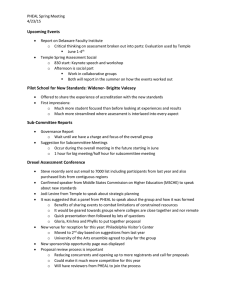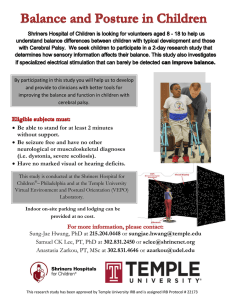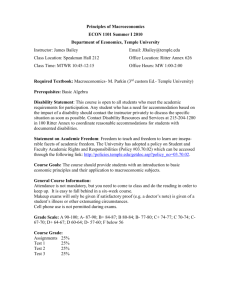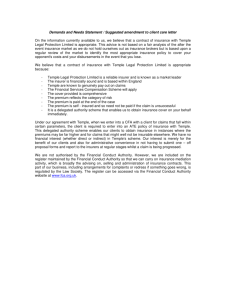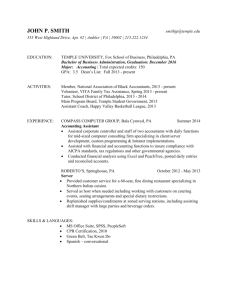Dr Catherine O’Keeffe, Lead for Faculty Development
advertisement
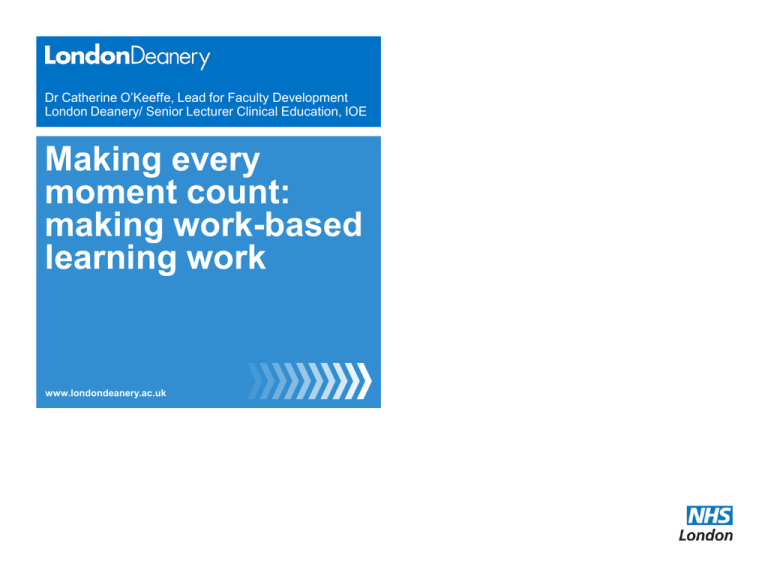
Dr Catherine O’Keeffe, Lead for Faculty Development London Deanery/ Senior Lecturer Clinical Education, IOE Making every moment count: making work-based learning work www.londondeanery.ac.uk Overview •Principles underpinning ‘making every moment count’ (Temple 2010) •Theories of learning in the workplace •Application to practice •Review Temple report recommendations Structured, coaching model of learning ‘What matters most …is not the hours… But what they do in those hours’ Adapting the learning environment to provide better training Temple (2010) Open to learning through teams and working with other disciplines Work-based learning theories Role Modelling Learning Environment Communities of Practice Modelling Scaffolding Fading Coaching Role Modelling Cognitive apprenticeship1: •Modelling •Scaffolding/fading •Coaching •Articulation •Reflection •Exploration 1 Collins et al (1991) Communities of Practice Learning as social processes that comes largely from our participation in workplace activities - Lave and Wenger (1991) Members of a community of practice are practitioners who: • share experiences, ways of addressing problems –shared practice •Discuss ways of addressing issues in relation to a shared interest, enabling members to take part in joint activities and dialogue, often leading to improvements in practice From peripheral to full participation Members progress from ‘new comer’ to ‘old timer’ or from peripheral to full participation through learning to ‘talk the talk’, ‘walk the walk’ through: •Working alongside experts •Immersion in professional discourses and behaviours •Gradually increasing contributions, building professional identity, confidence and esteem •Engaging in opportunities to transform practice, becoming a full participant in the professional community Learning environment – a continuum Restrictive learning environments – focus on immediate, task related training/ assessment to meet regulatory requirements Expansive learning environments – engage staff fully in a range of learning opportunities to meet the needs of both individual staff and the organisation (Fuller and Unwin 2004) Learning environments – a continuum 1 Restrictive: Expansive: Ambivalent support for trainee’s status as a learner Explicit support for trainee as a learner Focus on primary community of practice Participation in multiple communities of practice Rigid specialist roles Teamwork valued Uni-dimensional top-down view of Multi-dimensional view of expertise expertise Training used to tailor individual capability to organisational needs Training used as a vehicle for aligning the goals of developing both the individual and the organisation Reliance on trainees to deliver care 2 Recognises the doctor as learner 3 1Fuller and Unwin (2006); 2 Temple (2010); 3 Swanwick (2005) ‘Theme tables’ Divide into three groups: Round One - for 15 minutes discuss: Your interpretation of the concept and how it may help explain current approaches used to support (or otherwise) learning in your clinical workplace? How its application to your practice/place of work could help trainees learn? Possible difficulties applying this concept and how difficulties may be over come? Make notes on flip Chart then pass the flip chart to the next ‘theme table’ Round two – 10 minutes Round three – 5 minutes Temple’s recommendations 1. Training must be planned, focused and individualised 2. Handovers must be effective, safe and supervised (patient and educational handovers) 3. Improved mentorship and support of trainees 4. Accelerated learning by using simulation and technology in a safe controlled environment 5. Implement better ways of training: Teamwork, coaching, learning from MDTs, individualised focus, involving trainees in decision making and innovation through collaborative relationship Further Study Institute of Education Masters in Clinical Education ( Postgraduate Diploma, Certificate, Short courses) http://www.ioe.ac.uk/study/masters/PMM9_CLE.html Researching Learning in Clinical Practice ( RLCP) network: Email: c.okeeffe@ioe.ac.uk References/ further reading Collins, A et al (1989) Cognitive Apprenticeship: Making Thinking Visible American Educator, Vol. 6, No. 11. (1991), pp. 38-46. Fuller, A. and UNWIN, L. (2004) 'Expansive learning environments: integrating personal and organisational development,' H., Fuller, A. and Munro, A. (eds) , Workplace Learning in Context. London: Routledge.. Lave, J and Wenger, E (1991) ‘Practice, person , social world’ pp 46-58 Chapter 2 in Situated Learning: Legitimate Peripheral Participation. Cambridge: Cambridge University Press. Temple, J ( 2010) Time for Training: A Review of the impact of the European Working Time Directive on the quality of training. http://www.mee.nhs.uk/PDF/14274%20Bookmark%20Web%20Version.pdf Swanwick, T (Ed) ( 2010) Understanding Medical Education: Evidence, Theory and Practice. Chichester: Wiley-Blackwell Resources www.Infed.org


